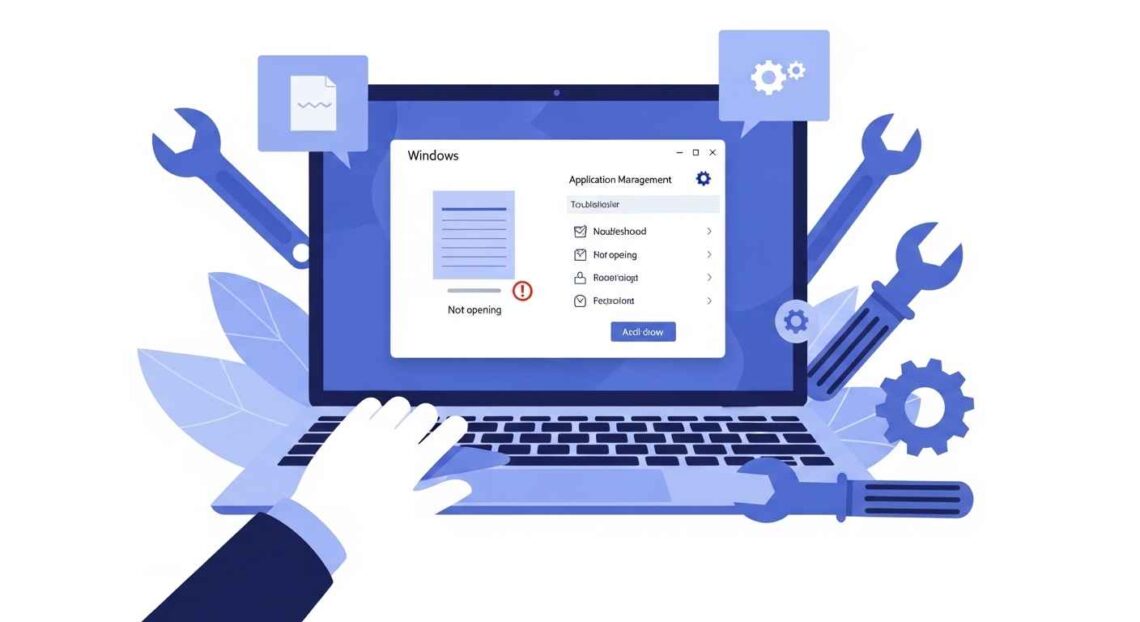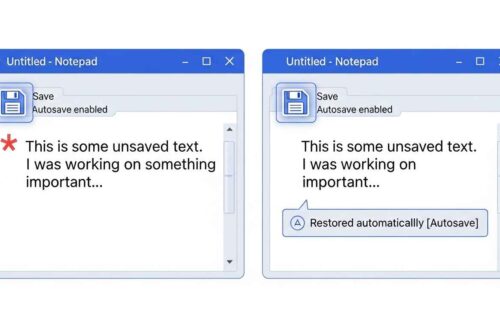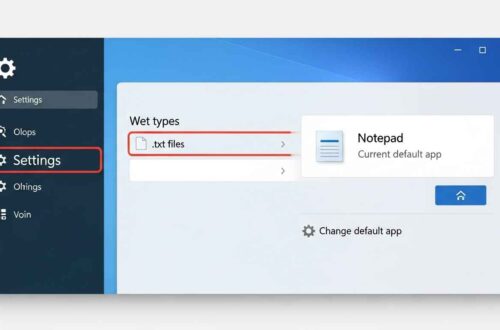Notepad is one of the simplest and most used apps in Windows. Whether you’re taking quick notes, editing a .txt file, or tweaking system settings, Notepad is a go-to tool for millions of users.
But what happens when Notepad won’t open — no matter how many times you click it? 😩
If you’re double-clicking Notepad and nothing happens — or it briefly appears and disappears — don’t worry. This is a common Windows issue that can be fixed easily.
In this guide, we’ll explore why Notepad stops opening, the most effective fixes, and how to prevent it from happening again.
Common Reasons Why Notepad Won’t Open
Before jumping into fixes, it’s important to know what’s causing the issue.
Here are the most common reasons:
- ⚙️ Corrupted Notepad app files
- 🧱 Windows update glitch or missing system component
- 🔒 Registry errors preventing Notepad from launching
- 💻 Default app settings broken (e.g., file associations)
- 🧩 User profile corruption
- 🦠 Malware or third-party apps blocking Notepad
- ⚡ Insufficient permissions or missing system resources
Once you understand the cause, fixing it becomes much easier.
Fix 1: Restart Your Computer
It sounds simple — but it often works.
Windows processes sometimes get stuck in the background, preventing certain apps (like Notepad) from opening.
Just restart your computer, and then try launching Notepad again.
💡 Tip: Use Ctrl + Alt + Del → Task Manager and make sure no “Notepad.exe” process is already running before reopening it.
Fix 2: Open Notepad via Command Prompt
Sometimes the shortcut or icon may not work — but the app itself is fine.
You can try opening Notepad manually through Command Prompt:
- Press Windows + R to open the Run box.
- Type
cmdand press Enter. - In the Command Prompt window, type:
notepad - Press Enter.
If Notepad opens, your shortcut or Windows Start link might be corrupted.
In that case, you can easily create a new shortcut (explained below).
Fix 3: Recreate a New Notepad Shortcut
If you can’t launch Notepad from the Start Menu or taskbar, create a fresh shortcut:
- Right-click on the Desktop → New → Shortcut.
- In the location box, paste:
C:\Windows\System32\notepad.exe - Click Next, name it “Notepad,” and press Finish.
Now, double-click your new shortcut — it should open normally.
💡 Bonus Tip: Right-click the new shortcut → Pin to Taskbar for quick access.
Fix 4: Use Windows Search
Sometimes the Notepad app is hidden due to an update or a menu glitch.
To find it:
- Press Windows + S or click the Search icon.
- Type Notepad.
- If it appears, right-click → Run as Administrator.
If Windows says “App not found,” move to the next fix — Notepad may have been removed accidentally.
Fix 5: Reinstall Notepad from Optional Features
Windows 10 and 11 treat Notepad as an optional feature, which means it can be uninstalled or disabled.
Here’s how to reinstall it:
Windows 11:
- Go to Settings → Apps → Optional features.
- Click View features (next to Add an optional feature).
- Search for Notepad.
- Check it → Click Install.
Windows 10:
- Open Settings → Apps → Apps & Features.
- Click Optional features → Add a feature.
- Search for Notepad and install it.
Once done, restart your PC and try again.
💡 This method works 90% of the time for users who lost Notepad after a Windows update.
Fix 6: Repair or Reset the Notepad App
If Notepad is installed but won’t launch, it might be corrupted.
You can fix it from the Windows Settings panel.
Here’s how:
- Open Settings → Apps → Installed apps (Windows 11) or Apps & Features (Windows 10).
- Scroll down and find Notepad.
- Click the three dots (⋯) → Advanced options.
- Choose Repair first.
- If that doesn’t work, choose Reset.
This reinstalls Notepad’s core files without affecting your system.
Fix 7: Check File Associations
If double-clicking a .txt file doesn’t open Notepad, the default app might have changed.
To fix it:
- Right-click any
.txtfile → Open with → Choose another app. - Select Notepad.
- Tick Always use this app to open .txt files.
- Click OK.
Now, all text files will automatically open in Notepad again.
Fix 8: Use Windows PowerShell to Reinstall Notepad
If none of the above work, you can reinstall Notepad using PowerShell.
Steps:
- Press Windows + X → select Windows PowerShell (Admin).
- Copy and paste this command:
Add-WindowsCapability -Online -Name "Microsoft.Windows.Notepad~~~~0.0.1.0" - Press Enter and wait for it to install.
- Restart your PC.
Now search for “Notepad” again — it should appear.
Fix 9: Scan and Repair System Files
Sometimes Notepad doesn’t open because Windows system files are corrupted.
You can fix this with two built-in tools: SFC and DISM.
Step 1: Run System File Checker
- Open Command Prompt as Administrator.
- Type:
sfc /scannow - Wait until the scan completes (it can take 10–15 minutes).
Step 2: Run DISM (if SFC fails)
- In the same Command Prompt, type:
DISM /Online /Cleanup-Image /RestoreHealth - Press Enter and let it finish.
Once done, restart your PC and try opening Notepad again.
Fix 10: Check for Windows Updates
Microsoft often fixes app bugs through regular updates.
To make sure you’re not running an outdated version:
- Go to Settings → Windows Update.
- Click Check for updates.
- Install any pending updates and restart your PC.
After updating, Notepad often works again without extra steps.
Fix 11: Create a New User Account
If Notepad still doesn’t open, your user profile might be corrupted.
To check:
- Go to Settings → Accounts → Family & other users.
- Click Add account → choose “I don’t have this person’s sign-in info.”
- Create a local user account.
- Log in with that new account and try opening Notepad.
If it works there, your old user profile was damaged — you can transfer files to the new one.
Fix 12: Use Alternative Text Editors
If you need to edit text files urgently and Notepad just won’t open, use a temporary alternative:
- 🟢 Notepad++ — free, powerful, supports multiple tabs
- 🟢 Visual Studio Code — great for programming or notes
- 🟢 Atom — customizable open-source editor
All of these are free and far more advanced than classic Notepad.
Bonus Tip: Check for Malware
Rarely, viruses or malicious scripts can block or replace system apps like Notepad.
Use Windows Defender or any trusted antivirus and run a full system scan to rule this out.
Go to:
Start → Windows Security → Virus & threat protection → Full scan
Summary Table
| Cause | Solution |
|---|---|
| App glitch | Restart PC |
| Shortcut broken | Create new shortcut |
| App missing | Reinstall via Optional Features |
| Corrupted app files | Repair or Reset Notepad |
| System file corruption | Run SFC / DISM |
| User profile error | Create new user account |
| File association issue | Set Notepad as default app |
| Malware interference | Scan for viruses |
Final Thoughts
When Notepad doesn’t open, it’s usually a minor Windows configuration issue, not a serious system failure.
Start with simple fixes like restarting the PC or reinstalling Notepad, and you’ll likely solve it in minutes.
If you often face app glitches, keep your system updated and run occasional maintenance scans.
And remember — if you ever get stuck, tools like Notepad++ or VS Code can be handy alternatives.
With these methods, you can quickly bring Notepad back to life and get back to work without interruptions.





